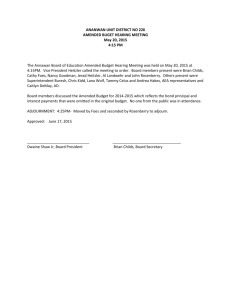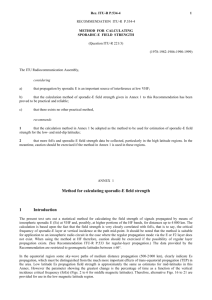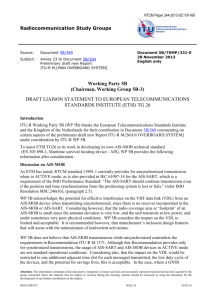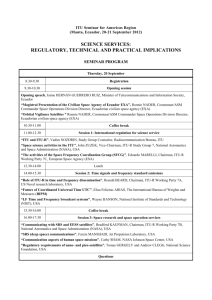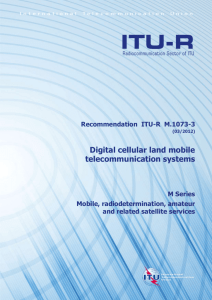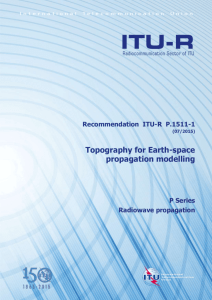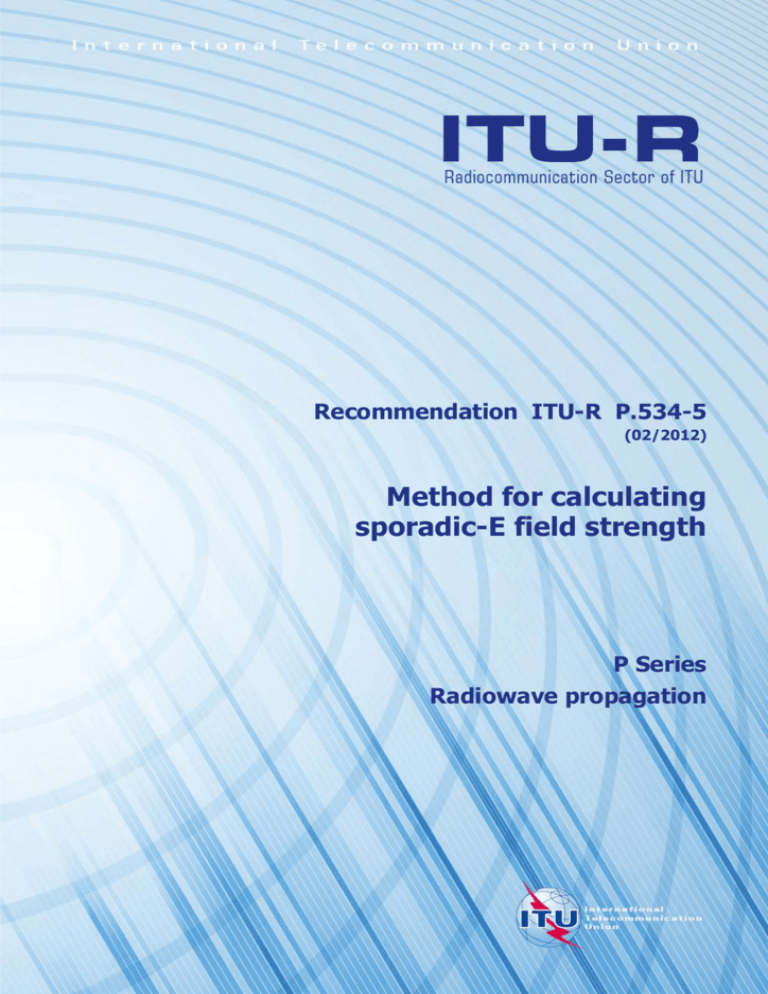
Recommendation ITU-R P.534-5
(02/2012)
Method for calculating
sporadic-E field strength
P Series
Radiowave propagation
ii
Rec. ITU-R P.534-5
Foreword
The role of the Radiocommunication Sector is to ensure the rational, equitable, efficient and economical use of the
radio-frequency spectrum by all radiocommunication services, including satellite services, and carry out studies without
limit of frequency range on the basis of which Recommendations are adopted.
The regulatory and policy functions of the Radiocommunication Sector are performed by World and Regional
Radiocommunication Conferences and Radiocommunication Assemblies supported by Study Groups.
Policy on Intellectual Property Right (IPR)
ITU-R policy on IPR is described in the Common Patent Policy for ITU-T/ITU-R/ISO/IEC referenced in Annex 1 of
Resolution ITU-R 1. Forms to be used for the submission of patent statements and licensing declarations by patent
holders are available from http://www.itu.int/ITU-R/go/patents/en where the Guidelines for Implementation of the
Common Patent Policy for ITU-T/ITU-R/ISO/IEC and the ITU-R patent information database can also be found.
Series of ITU-R Recommendations
(Also available online at http://www.itu.int/publ/R-REC/en)
Series
BO
BR
BS
BT
F
M
P
RA
RS
S
SA
SF
SM
SNG
TF
V
Title
Satellite delivery
Recording for production, archival and play-out; film for television
Broadcasting service (sound)
Broadcasting service (television)
Fixed service
Mobile, radiodetermination, amateur and related satellite services
Radiowave propagation
Radio astronomy
Remote sensing systems
Fixed-satellite service
Space applications and meteorology
Frequency sharing and coordination between fixed-satellite and fixed service systems
Spectrum management
Satellite news gathering
Time signals and frequency standards emissions
Vocabulary and related subjects
Note: This ITU-R Recommendation was approved in English under the procedure detailed in Resolution ITU-R 1.
Electronic Publication
Geneva, 2012
ITU 2012
All rights reserved. No part of this publication may be reproduced, by any means whatsoever, without written permission of ITU.
Rec. ITU-R P.534-5
1
RECOMMENDATION ITU-R P.534-5
Method for calculating sporadic-E field strength
(Question ITU-R 221/3)
(1978-1982-1986-1990-1999-2012)
The ITU Radiocommunication Assembly,
considering
a)
that propagation by sporadic E is an important source of interference at low VHF;
b)
that the calculation method of sporadic-E field strength given in Annex 1 to this
Recommendation has been proved to be practical and reliable;
c)
that there exists no other practical method,
recommends
1
that the calculation method in Annex 1 be adopted as the method to be used for estimation
of sporadic-E field strength for the low- and mid-dip latitudes;
2
that more foEs and sporadic-E field strength data be collected, particularly in the high
latitude regions. In the meantime, caution should be exercised if the method in Annex 1 is used in
these regions.
Annex 1
Propagation by sporadic E
1
Introduction
The present text sets out a statistical method for calculating the field strength of signals propagated
by means of ionospheric sporadic E (Es) at VHF and, possibly, at higher portions of the HF bands,
for distances up to 4 000 km. The calculation is based upon the fact that the field strength is very
closely correlated with foEs, that is to say, the critical frequency of sporadic-E layer at vertical
incidence at the path mid-point. It should be noted that the method is suitable for application to an
ionospheric radio circuit in the case where the regular propagation mode via the E or F2 layer does
not exist. When using the method at HF therefore, caution should be exercised if the possibility of
regular layer propagation exists. (See Recommendation ITU-R P.533 for regular-layer propagation.)
The data provided by the Recommendation are restricted to geomagnetic latitudes between 60°.
2
Rec. ITU-R P.534-5
In the equatorial region some sky-wave paths of medium distance propagation (500-2 000 km),
clearly indicate Es propagation, which must be distinguished from the much more important effects
of trans-equatorial propagation (TEP) in the area. Low latitude Es propagation field strength is
approximately the same as estimates for mid-latitudes in this Annex. However the parameter
showing the greatest change is the percentage of time as a function of the vertical incidence critical
frequency (foEs) (Figs. 2 to 6 for middle magnetic latitudes). Therefore, alternative Figs. 16 to 21
are provided for use in the low magnetic latitude region.
The method has the following features:
–
Es field strength is predicted by means of the statistical correspondence of a value of
ionospheric attenuation to that of foEs at a given rate of occurrence;
–
the ionospheric attenuation of the Es signal is represented by a function of the ratio of the
signal frequency f to foEs and the surface distance between the transmitting and receiving
stations;
–
some useful probability charts and world maps of foEs are provided for quick and easy
evaluation of the Es field strength.
2
Formula for sporadic-E field strength
Es field strength or receiver input voltage can be expressed as follows:
E E0 P Gt – Lt –
dB
(1)
E0 104.8 – 20 log l
dB
(1a)
V = V0 + P + Gt + Gr – Lt – Lr –
(2)
V0 = 133 – 20 log l – 20 log f
(2a)
where
E:
predicted field strength (dB(V/m))
E0 :
theoretical inverse distance field strength (dB(V/m)), for 1 kW radiated power
and isotropic transmitting antenna
V:
V0 :
P:
Gt :
median voltage developed across receiver input terminals (dB(V))
theoretical inverse distance receiver input voltage, for 1 kW radiated power and
isotropic transmitting and receiving antenna matched to 50 feeder for a
signal frequency of f (MHz)
transmitter power (dB(1 kW))
gain of the transmitting antenna relative to an isotropic antenna, (dB)
Gr :
gain of the receiving antenna relative to an isotropic antenna, (dB)
Lt :
Lr :
losses including feeder loss and mismatch loss of the transmitting antenna,
(dB)
losses including feeder loss and mismatch loss of the receiving antenna, (dB)
:
l:
f:
ionospheric attenuation (dB) as shown by the broken line curves in Fig. 1
transmission path length (km), (see equation (5))
signal frequency (MHz).
Rec. ITU-R P.534-5
3
For the calculation by computer, for single-hop propagation signal, (1
approximately by:
40
(1 hop ) (d )
0.2
2
d
d
1
130
250
hop)(d ),
is given
2
d f
2 600 foEs
2
d – 1 660
exp
280
(3)
and for double-hop propagation signal, (2 hop)(d ) approximately by:
d
(2 hop) (d ) 2.6 (1 hop)
2
(4)
and
l : transmission path length (km) is given by:
l 2 R02 ( R0 h) 2 – 2R0 ( R0 h) cos(d /(2R0 )) 1/ 2
(5)
where:
R0 :
h:
d:
f:
foEs :
effective radius of the Earth, 8 500 km
height of Es layer, 120 km
surface distance between the transmitting and receiving stations (km)
signal frequency (MHz)
critical frequency of sporadic-E at vertical incidence at a given rate of
occurrence (MHz).
The accuracy with which equations (3) and (4) reproduce the measured values of is indicated in
Fig. 1 where they are plotted as the broken line curves. The use of equation (3) should be restricted
to distances less than 2 600 km with the values of f/foEs between 1 and 8, where the error is less
than 5 dB. The use of equation (4) should be restricted to distances between 2 600 and 4 000 km,
and to values of f/foEs between 2 and 5.5; the error will then be less than 10 dB.
4
Rec. ITU-R P.534-5
FIGURE 1
Chart of ionospheric attenuation for Es propagation
Single-hop propagation
Double-hop propagation
70
60
Ionospheric attenuation (dB)
5.5
50
4.5
40
3.5
30
20
2.5
f/foEs=2
10
f/foEs=1
0
0
1 000
2 000
3 000
4 000
Surface distance d (km)
from observed values
from empirical formulae (3) and (4)
3
A procedure for calculating sporadic-E field strength
A procedure for calculating Es field strength is as follows:
Step 1 : calculate a value of E0 (or V0) corresponding to given value of l using equation (1a) (or
equation (2a)).
Step 2a : (path mid-point dip latitude outside 20°) : read off a value of foEs at a given time
percentage of occurrence in the desired region and season using one of Figs. 2 to 6. If a
more accurate prediction is required, read off a value of the percentage of time that foEs
exceeds 7 MHz at the path mid-point using a pertinent map of Figs. 12 to 15 and
determine a value of foEs by drawing a new line on the relevant one of Figs. 2 to 6 as
described in § 4.1. If a prediction of diurnal variation is required, read off a value of foEs
on a pertinent figure of Figs. 7 to 11.
Step 2b : (path mid-point dip latitude within 20°) : determine the dip angle for the ionospheric
reflection point and read off a value of foEs at a given percentage of time of occurrence
under the desired region and season using Figs. 16 to 21.
Step 3 : calculate f/foEs.
Step 4 :
using the broken line curves in Fig. 1, read off a value of corresponding to the given
value of d and the calculated f/foEs, or, for an approximate value, calculate using
equations (3) and (4).
Rec. ITU-R P.534-5
Step 5 :
4
5
calculate the predicted value of E (or V) by equation (1) (or (2)), using given values of P,
Gt, Gr, Lt, Lr and the value obtained for .
Probability of occurrence of foEs
It is necessary to clarify the statistical characteristics of foEs since it undergoes sporadic behaviour
changes with location and time. The world map of foEs, such as that in Recommendation ITU-R
P.1240, can be used for high accuracy of prediction. On the other hand, simplified statistical data of
foEs are also very useful in cases where the general tendency of temporal variation is to be
obtained.
For the purpose of predicting the average Es field strength, probability curves of foEs have been
prepared for the five mid-latitude regions of Europe and North Africa, North America, Asia (Far
East), South America and a buffer region between these regions as shown in Figs. 2 to 11. For low
latitudes, probability curves of foEs have been prepared for America, Asia and Africa as shown in
Figs. 16 to 21. The high latitude region characteristics need to be further clarified in the future.
4.1
Mid-latitudes
To provide detailed geographic characteristics of foEs, the world maps of the percentage of time for
which foEs is equal to or greater than 7 MHz during the months of May-August (northern summer),
November-February (southern summer), the months of March, April, September and October
(equinoctial months, north and south) and for twelve months, are specifically included as Figs. 1215. As may be seen in these world maps, contours of time percentage are shown between 60°
geomagnetic (or dipole) north and south latitudes. A low latitude region around the dip equator is
excluded.
Figures 2 to 6 show the relation between the value of foEs and the time percentage of its
occurrence. In these figures, curves for the summer months, winter months and equinoctial months
are all represented by straight lines connecting two points corresponding to values of time
percentage exceeding 7 MHz and 10 MHz, respectively, of foEs. These are subject to the so-called
Phillips’ frequency-dependence rule. This rule is a strictly empirical one which works quite well at
mid-latitudes for percentages of time less than about 30% and for frequencies above foE, the critical
frequency of the normal E layer. Caution should be exercised in the use of the Phillips rule for
frequencies above about 100 MHz and for equatorial and high latitudes. The Phillips rule is:
log p a b f
(6)
where:
p:
f:
a and b :
probability of occurrence of foEs f
frequency (MHz)
adjustable constants, such that b is the slope in a plot of log p as a function of f.
A curve showing the annual average, has values of time percentage of about one third of the
corresponding values for the summer months in the low percentage of time ranges. For reference,
probability curves are added to the respective figures for the period of daytime (0800-2300 h) in the
summer months, when the most intense sporadic E is observed.
When there exists a difference between a value of time percentage of foEs for 7 MHz, as obtained
by the world maps in Figs. 12, 13, 14 or 15 and that obtained by the average probability curve for a
Region, as seen in Figs. 2 to 6, a value of foEs may be determined for a given percentage of time,
by using a new probability curve redrawn so as to be parallel to the original curve in the respective
region and displaced by an amount equal to the difference of those values.
6
Rec. ITU-R P.534-5
Figures 7 to 11 exhibit diurnal variations of occurrence of foEs in a time block of 4 h in the above
four regions for the summer and non-summer months, according to their distinctive characteristics.
It is noticeable that a definite minimum of foEs is observed shortly after midday in regions B and C,
particularly in summer. For the purpose of predicting the detailed behaviour of Es signal strength, it
may be necessary to show the diurnal variations of foEs in terms of a time block smaller than 4 h.
4.2
Low latitudes
Figures 16 to 21 show the relation between the value of foEs and the time percentage of its
occurrence for low latitudes. In these figures, a clear difference is observed between a very narrow
belt around the dip equator ( 6° dip angle) and the adjacent region up to 20° dip, which might be
called equatorial and sub-equatorial regions respectively. As seen from comparison with Figs. 2
to 6, the sub-equatorial region, but not the equatorial one, is subject to the Phillips law.
FIGURE 2
Values of foEs equalled or exceeded for indicated percentage of time for region A
5
2
10
Percentage of time
5
2
1
5
2
10
–1
5
2
10
–2
2
4
6
8
10
12
14
foEs (MHz)
Region A:
I:
II:
III:
IV:
V:
Europe and North Africa
May to August (0800-2300 h)
May to August
annual average
March, April, September and October
November to February
16
18
Rec. ITU-R P.534-5
7
FIGURE 3
Values of foEs equalled or exceeded for indicated percentage of time for region B
5
2
10
Percentage of time
5
2
1
5
2
10
–1
5
2
10
–2
2
4
6
8
10
12
14
foEs (MHz)
Region B:
I:
II:
III:
IV:
V:
North America
May to August (0800-2300 h)
May to August
annual average
March, April, September and October
November to February
16
18
8
Rec. ITU-R P.534-5
FIGURE 4
Values of foEs equalled or exceeded for indicated percentage of time for region C
5
2
10
Percentage of time
5
2
1
5
2
–1
10
5
2
–2
10
2
4
6
8
10
12
14
foEs (MHz)
Region C:
I:
II:
III:
IV:
V:
Asia (Far East)
May to August (0800-2300 h)
May to August
annual average
March, April, September and October
November to February
16
18
Rec. ITU-R P.534-5
9
FIGURE 5
Values of foEs equalled or exceeded for indicated percentage of time for region D
5
2
10
Percentage of time
5
2
1
5
2
–1
10
5
2
–2
10
2
4
6
8
10
12
14
foEs (MHz)
Region D:
II:
III:
IV:
V:
VI:
South America
May to August
annual average
March, April, September and October
November to February
November to February (0800-2300 h)
16
18
10
Rec. ITU-R P.534-5
FIGURE 6
Values of foEs equalled or exceeded for indicated percentage of time
5
2
10
W
E
M
S1
Percentage of time
5
2
S2
1
5
2
10
–1
5
2
10
–2
2
4
6
8
10
foEs (MHz)
Mean value:
S1:
S2:
M:
E:
W:
regions A, B, C and D
summer
summer (0800-2300 h)
annual average
equinox
winter
12
14
16
18
Rec. ITU-R P.534-5
11
FIGURE 7
Values of foEs equalled or exceeded for the percentage of time indicated as the parameter
on the curve during time blocks shown separated by the dotted vertical lines of 4 hours
for region A (Europe and North Africa)
22
20
18
foEs (MHz)
16
14
14
0.1%
0.2
12
12
0.5
10
10
0.1%
8
0.2
8
0.5
6
6
4
4
0
2
4
6
8 10 12 14 16 18 20 22 24
0
2
4
6
8
10 12 14 16 18 20 22 24
Local time
Local time
Summer
Spring
Autumn
Winter
12
Rec. ITU-R P.534-5
FIGURE 8
Values of foEs equalled or exceeded for the percentage of time indicated as the parameter
on the curve during time blocks shown separated by the dotted vertical lines of 4 hours
for region B (North America)
22
20
18
16
foEs (MHz)
0.1%
14
0.2
14
12
0.5
12
0.1%
10
10
8
8
6
6
0.2
0.5
4
4
0
2
4
6
8 10 12 14 16 18 20 22 24
0
2
4
6
8 10 12 14 16 18 20 22 24
Local time
Local time
Summer
Spring
Autumn
Winter
Rec. ITU-R P.534-5
13
FIGURE 9
Values of foEs equalled or exceeded for the percentage of time indicated as the parameter
on the curve during time blocks shown separated by the dotted vertical lines of 4 hours
for region C (Asia (Far East))
22
0.1%
20
0.2
18
0.5
foEs (MHz)
16
14
14
12
12
0.1%
0.2
10
10
8
8
6
6
0.5
4
4
0
2
4
6
8 10 12 14 16 18 20 22 24
0
2
4
6
8 10 12 14 16 18 20 22 24
Local time
Local time
Summer
Spring
Autumn
Winter
14
Rec. ITU-R P.534-5
FIGURE 10
Values of foEs equalled or exceeded for the percentage of time indicated as the parameter
on the curve during time blocks shown separated by the dotted vertical lines of 4 hours
for region D (South America)
22
20
18
16
foEs (MHz)
0.1%
14
14
0.2
12
12
0.1%
0.5
10
0.2
10
0.5
8
8
6
6
4
0
2
4
6
4
8 10 12 14 16 18 20 22 24 0
2
4
6
8 10 12 14 16 18 20 22 24
Local time
Local time
Summer
Spring
Autumn
Winter
Rec. ITU-R P.534-5
15
FIGURE 11
Mean values of foEs equalled or exceeded for the percentage of time indicated as the parameter
on the curve during time blocks shown separated by the dotted vertical lines of 4 hours
for regions A, B, C and D
22
20
18
foEs (MHz)
16
0.1%
0.2
14
14
0.5
12
12
10
10
8
8
6
6
0.1%
4
0
2
4
6
4
8 10 12 14 16 18 20 22 24 0
0.2
0.5
2
4
6
8 10 12 14 16 18 20 22 24
Local time
Local time
Summer
Spring
Autumn
Winter
16
Rec. ITU-R P.534-5
FIGURE 12
0.5
F = 60º S
0.5
A: low latitude region (see § 4)
1.5
0.25
7.5
0.75
12.5
F = 60º N
1.5
1.25
17.5
12.5
1.5
1.25
7.5
Longitude
7.5
0.75
0.25
0.5
Percentage of time for which sporadic E (foEs) equals or exceeds 7 MHz at vertical incidence
in the mid-latitude zones for the months May, June, July and August
Latitude
Rec. ITU-R P.534-5
17
FIGURE 13
0.5
Longitude
A: low latitude region (see § 4)
1.5
0.25
0.5
0.75
F = 60º S
F = 60º N
1.5
0.25
0.5
0.75
0.25
0.15
0.75
Percentage of time for which sporadic E (foEs) equals or exceeds 7 MHz at vertical incidence
in the mid-latitude zones for the months November, December, January and February
Latitude
18
Rec. ITU-R P.534-5
FIGURE 14
A: low latitude region (see § 4)
F = 60º S
0.25
0.5
0.75
Latitude
0.25
F = 60º N
0.5
0.75
1.5
2.5
1.5
0.75
2.5
Longitude
2.5
1.5
0.5
0.1
0.25
1.5
0.75
0.75
0.5
0.25
0.25
Percentage of time for which sporadic E (foEs) equals or exceeds 7 MHz at vertical incidence
in the mid-latitude zones for the months March, April, September and October
Rec. ITU-R P.534-5
19
FIGURE 15
Longitude
0.75
A: low latitude region (see § 4)
F = 60º S
1.5
2.5
1.5
Latitude
F = 60º N
2.5
2.5
2.5
1.5
0.5
2.5
2.5
1.5
1.5
0.5
0.75
Percentage of time for which sporadic E (foEs) equals or exceeds 7 MHz at vertical incidence
in the mid-latitude zones during the 12 months of the year
20
Rec. ITU-R P.534-5
FIGURE 16
Values of foEs equalled or exceeded for indicated percentage of time
2
10
5
2
10
Percentage of time
5
2
1
5
2
–1
10
5
2
–2
10
0
2
4
6
8
10
12
14
foEs (MHz)
Region E: Equatorial Asia ( 6 ° dip latitude)
I: maximum solar activity years (0600-1800 h).
Annual average
II: maximum solar activity years.
Annual average
III: median and low solar activity years (0600-1800 h).
Annual average
IV: median and low solar activity years.
Annual average
16
Rec. ITU-R P.534-5
21
FIGURE 17
Values of foEs equalled or exceeded for indicated percentage of time
2
10
5
2
10
Percentage of time
5
2
1
5
2
–1
10
5
2
–2
10
0
2
4
6
8
10
foEs (MHz)
Region E: Sud-equatorial Asia (between
6 ° and 20 ° dip latitude)
I: summer (0600-1800 h)
II: summer
III: annual average
IV: equinox
V: winter
12
14
16
22
Rec. ITU-R P.534-5
FIGURE 18
Values of foEs equalled or exceeded for indicated percentage of time
2
10
5
2
10
Percentage of time
5
2
1
5
2
–1
10
5
2
–2
10
0
2
4
6
8
10
12
14
foEs (MHz)
Region F: Equatorial Africa ( 6 ° dip latitude)
I: annual average (0600-1800 h)
II: annual average
Note – Differences between seasons are smaller than the annual
average error. Also there is no significant change with solar activity.
16
Rec. ITU-R P.534-5
23
FIGURE 19
Values of foEs equalled or exceeded for indicated percentage of time
2
10
5
2
10
Percentage of time
5
2
1
5
2
–1
10
5
2
–2
10
0
2
4
6
8
10
foEs (MHz)
Region F: Sub-equatorial Africa (between
6 ° and 20 ° dip latitude)
I: summer (0600-1800 h)
II: summer
III: annual average and equinox
IV: winter
12
14
16
24
Rec. ITU-R P.534-5
FIGURE 20
Values of foEs equalled or exceeded for indicated percentage of time
10
2
5
2
10
Percentage of time
5
2
1
5
2
10
–1
5
2
10
–2
0
2
4
6
8
10
12
foEs (MHz)
Region G: Equatorial America ( 6 °dip latitude)
I: annual average (0600-1800 h)
II: annual average
Note – Differences between seasons are smaller than the annual
average error.
14
16
Rec. ITU-R P.534-5
25
FIGURE 21
Values of foEs equalled or exceeded for indicated percentage of time
10
2
5
2
10
Percentage of time
5
2
1
5
2
10
–1
5
2
10
–2
0
2
4
6
8
10
12
foEs (MHz)
Region G: Sub-equatorial America (between
6 ° and 20° dip latitude)
I: annual average (0600-1800 h)
II: annual average
Note – Differences between seasons are smaller than the annual
average error.
14
16
26
4.3
Rec. ITU-R P.534-5
Global maps of foEs exceeded for annual percentage times
To facilitate computer based predictions a set of maps of the critical frequency for sporadic E, foEs
(MHz) not exceeded for annual average time percentages of 50%, 10%, 1% and 0.1% have been
developed. These maps were based on a global data set containing long-term measurements from
101 Ionosonde stations. These are available in electronic format from ITU-R Study Group 3
website. An example of the 50% map is given in Fig. 22.
FIGURE 22
FoEs (MHz) not exceeded for more than 50% of the average year
2.5
2.5
2.5
3.5
3.5
2 .5
3 .5
2.5
2.5
2.5
2.5
5
3.
3. 5
2.5
2.5
3.5
5
2.5
Latitude
3.
3.5
3 .5
2.
2.5
5
2. 5
2.
5
3.5
2.5
2.5
2.5
2.5
Longitude
5
Sporadic-E prediction based on annual-statistics maps
This method gives sporadic-E basic transmission loss not exceeded for a given percentage of
an average year based on maps of foEs exceeded for 0.1%, 1%, 10% and 50% of an average year.
It is intended primarily for computer implementation where a smooth variation of predicted loss
with location is required, primarily to predict interference on long paths for low and mid-latitudes.
The method should not be considered reliable at low or high geomagnetic latitudes.
The calculation includes terminal shielding, which varies according to take-off angle. Thus for all
path lengths the calculation is made for both 1 hop and 2 hops. These two results are combined at
the end of the procedure.
Where information is not available on a terminal horizon elevation angle and distance, an estimate
should be used. If the terrain in the area is concerned is known to smooth or include large areas of
water, it is possible for surface reflections to contribute to ionospheric propagation, with a consequent
reduction in losses. The following method does not attempt to estimate this effect.
5.1
Derivation of foEs
For a given p% time, set the percentage-time values used for interpolation or extrapolation. p1 and
p2, according to Table 1.
Rec. ITU-R P.534-5
27
TABLE 1
Conditions for setting p1 and p2
p% time
p1
p2
p < 1%
0.1%
1%
1% ≤ p ≤ 10%
1%
10%
10% < p
10%
50%
For a given location, obtain foEs1 and foEs2 from the maps of foEs exceeded for p1 and p2% time
respectively. Calculate foEs exceeded for p% time using:
foEs foEs1 foEs 2 foEs1 log p / p1 / log p2 / p1
5.2
(MHz)
(7)
Horizon elevation angles
Additional attenuation can be caused by terrain obstruction at either terminal.
For each terminals, find the terrain point along the great-circle path from the terminal towards the
other terminal with the highest elevation angle above the local horizontal as viewed from the
terminal. The elevation angle of a given terrain point is given by:
h p ha
dp
p arctan
1000d p 2 R0
(radians)
(8)
where:
dp:
hp :
ha :
distance to terrain point, km;
height of terrain point, m above sea level;
height of terminal antenna, m above sea level.
Perform this calculation twice, once for each terminal, to obtain the following:
εha,b: elevation angle to horizon at 1st, 2nd terminal, radians;
dha,b: distance to horizon at 1st, 2nd terminal, km.
5.3
Calculation for 1-hop propagation
Obtain foEs as calculated by equation (7) for the mid-point of the path to obtain the ionospheric loss
for one hop, Γ1, using equation (3).
Calculate the slope path length:
l1 2 R02 R0 h 2 2 R0 R0 h cosd / 2 R0
0.5
(km)
(9)
Free-space loss can now be calculated for the slope distance:
Lbfs1 32.4 20 log l1 f
(dB)
(10)
The ray take-off angle above the local horizontal at both terminals for 1 hop is given by:
r1 0.5 arctan
R0 sin 1
h R0 1cos 1
1
(radians)
(11)
where:
1 d / 2 R0
(radians)
(11a)
28
Rec. ITU-R P.534-5
The diffraction angles, in radians, for the two terminals are given by:
1a ,b ha ,b r1
(radians)
(12)
The corresponding diffraction parameters are given by:
1a ,b 3.651 f d ha ,b 1 cos1a ,b / cosha ,b
3.651 f d ha ,b 1 cos1a ,b / cosha ,b
if 1a,b 0
(13a)
otherwise
(13b)
The diffraction losses in dB at the two terminals are then given by:
Lp1a,b 6.9 20 log 1a,b 0.12 1 1a,b 0.1
0.0
if 1a,b 0.78
otherwise
(14a)
(14b)
Sporadic-E 1-hop basic transmission loss is now given by:
LbEs1 Lbfs1 1 L p1a L p1b
5.4
(dB)
(15)
Calculation for 2-hop propagation
Obtain foEs as the lower of the two values calculated by equation (7) at one-quarter and threequarters along the path to re-calculate Γ1 using equation (3) and thus obtain the ionospheric loss for
two hops, Γ2, using equation (4).
Calculate the slope path length:
l2 4 R02 R0 h 2 2 R0 R0 h cosd / 4 R0
0.5
(km)
(16)
Free-space loss can now be calculated for the slope distance:
Lbfs 2 32.4 20 log l2 f
(dB)
(17)
The ray take-off angle above the local horizontal at both terminals for 2 hops is given by:
r 2 0.5 arctan
R0 sin 1
h R0 1cos 1
(radians)
2
(18)
where:
2 d / 4 R0
(radians)
(18a)
The diffraction angles, in radians, for the two terminals are given by:
2 a ,b p 2 a ,b r 2
(radians)
(19)
The corresponding diffraction parameters are given by:
2a ,b 3.651 f d ha ,b 1 cos2 a ,b / cosha ,b
3.651 f d ha ,b 1 cos2a ,b / cosha ,b
if 2a,b 0
(20a)
otherwise
(20b)
The diffraction losses in dB at the two terminals are then given by:
Lp 2a,b 6.9 20 log 2a,b 0.12 1 2a,b 0.1
0.0
otherwise
if 2a,b 0.78
(21a)
(21b)
Rec. ITU-R P.534-5
29
Sporadic-E 2-hop basic transmission loss is now given by:
LbEs 2 Lbfs 2 2 L p 2a L p 2b
5.5
(dB)
(22)
Basic transmission loss
Basic sporadic-E transmission loss, Lb (dB) is now given by:
LbEs LbEs1
LbEs1 LbEs 2 20
(23a)
LbEs 2
LbEs 2 LbEs1 20
(23b)
10 log 100.1LbEs1 100.1LbEs2
otherwise
(23c)


